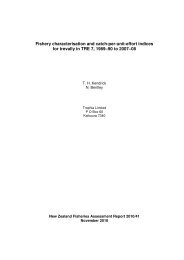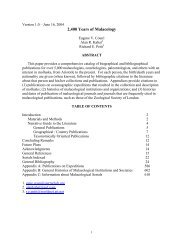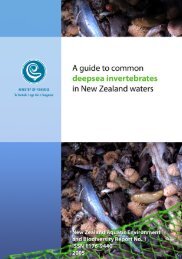N.Z. MARINE DEPARTMENT-FISHERIE,S BULLETIN No. .į
N.Z. MARINE DEPARTMENT-FISHERIE,S BULLETIN No. .į
N.Z. MARINE DEPARTMENT-FISHERIE,S BULLETIN No. .į
Create successful ePaper yourself
Turn your PDF publications into a flip-book with our unique Google optimized e-Paper software.
It will be observed from the foregoing records that the foocl of the large black<br />
shag varies according to the food available u,here it chooses to feecl; cloubtless, a<br />
wider range of foods would be shown if material was collected froll salt water. To<br />
what extent it selects or shows preference for special foods of those available<br />
where it chooses to feed is not known, except that generally fisli of one kind or<br />
another comprise the bulk of its food. Present eviclence simply shows that it feeds<br />
on such food as is available. There is no eviclence that it chooses certain areas<br />
because of the abundance of any particular kincl of fish or that its distribution<br />
is even principally governed by considerations of abunclance of food in general.<br />
The bird is knor,vn to nest and roost especially on cliffs on the sea coast and<br />
in trees overharging or near streams or lakes inlancl. Suitable cliffs are found<br />
only on parts of the coast, for example, round Banks Peninsula, and suitable<br />
inland sites vary in local abundance.<br />
It is not known whethel there are seasonal changes in the feeding grouncls of<br />
the coastal ancl inlancl colonies, to what extent inter:change and recruitment of one<br />
stock from the other takes place, or, indeed, whetl-rer cólonies remain, throughout<br />
the year, sufficiently distinct to vl'arrant separate consideration.<br />
To sum up the eviclence as regarcls the l{orth Island and Marlborough and<br />
Car-rterbury in the South Island, it is clear that a general condemnation of the black<br />
shag is unwarrantecl. The bird is shown to feed largely on trout in inland waters<br />
which contain trout, and largely on eels in shallow lakes and lagoons. A mixed<br />
cliet in r,vhich trout, eels, flounders, and mullet are conspicuous is taken in some<br />
tidal waters. The shag is not sho'rvn to be beneficial in any way to trout fisheries,<br />
for the only eels consurled, which were specifrcally identified, were of the shortfinned<br />
species (Falla and Stokell-Lake Ellesmere material). This species is<br />
not known to attack trout. It is 'Lrsually of a more suitable size for shags to eat,<br />
ancl is the numerically don-rinant eel at Lake Ellesmere and in the lower Waikato<br />
basin ancl generally in coastal lagoons and sluggish ticlal reaches of rivers, u,here<br />
shags have been reported most frec¡rcntly to take eels. The evideuce, so far as<br />
it extends, suggests that, on inland waters in tl-re parts of ldew Zealancl uncler<br />
discussion, the black shag is harmÍul rather than beneficial to trout fisheries.<br />
Too little is known o{ tl-re total number of bircls freciuenting inland lvaters to enable<br />
the significance of their depredations in lrlelv Zealand r¡iaters generally to be assessecl.<br />
Falla ancl Stokell cliscuss numbers of bircls in the <strong>No</strong>rth lsland and in Marlborough<br />
ancl Nelson. The numbers reported to ther-n lîay or may not be correct, ltut in the<br />
aggregate they suggest that the black shag is greatly less abundant inland than<br />
is suggested by annual reports of the Department of Internal Affairs. Reports<br />
for the four years ended March , 1941, show that the mean annual number of shags<br />
destroyecl in the Taupo and Rotorua districts was 1,311. Thereafter the total fell,<br />
at a time when ammunition was difÊcult to procure and most able-bodied men<br />
were in the armecl services. Reports from acclimatization societies do not usually<br />
give clear statements of.the numbers of shags destroyed and places lvhere thel'<br />
were killecl. More often they give the amount spent on bounties, sometimes without<br />
speciflcation of the amounts for different predators and often without clear statements<br />
as to numbers clestroyed by their staffs.<br />
Evidence of the feeding habits and local abundance of the large black shag in<br />
fresh waters in the southern half of the South Island is given by Williams (1945).<br />
Fisheries bulletin (N.Z. Marine Dept.) no. 9 (1948)<br />
ltze







